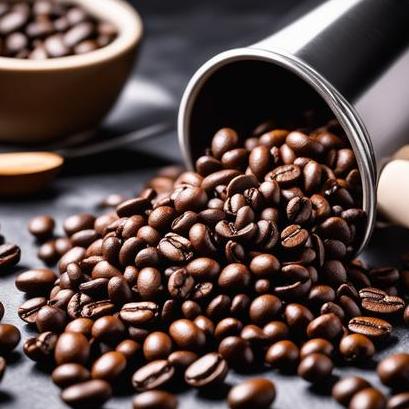
The Ultimate Guide To Roasting Coffee Beans In An Oven: A Delectable And Aromatic Adventure
Roasting your own coffee beans can transform an ordinary coffee experience into an extraordinary one. The process of roasting coffee beans allows you to control the flavor profile and unlock the delightful aromas hidden within those humble beans. In this comprehensive guide, we will explore the fascinating world of roasting coffee beans using an oven. From the science behind roasting to selecting the perfect beans, cleaning, preparation, tips, and a delicious recipe, this article covers every aspect of coffee bean oven roasting. So put on your apron, grab your favorite coffee beans, and let’s embark on this aromatic adventure together!
The Science Behind Coffee Bean Roasting
Before diving into the detailed process of roasting coffee beans in an oven, it’s essential to understand the science behind this magical transformation. Coffee beans start off as green, raw seeds harvested from coffee plants. The roasting process not only changes their color but also modifies their chemical composition, leading to the development of unique flavors and aromas.
During roasting, the beans undergo various chemical reactions that contribute to their exquisite taste. One crucial reaction is the Maillard reaction, which occurs between the amino acids and sugars present in the beans. This reaction produces a browning effect, enhancing the rich flavors and aromas of the coffee. Another vital process is the release of carbon dioxide gas from the beans, known as "degassing." This degassing phase is crucial, as freshly roasted beans require a brief period of rest before they can be brewed for the perfect cup of coffee.
Now that we understand the science behind roasting let’s move on to selecting the right beans for your coffee bean oven roasting adventure.
Selecting the Perfect Coffee Beans
Selecting high-quality beans is key to achieving exceptional results when oven-roasting coffee. Here are a few factors to consider:
1. Bean Variety
The two primary types of coffee beans are Arabica and Robusta. Arabica beans are known for their delicate and nuanced flavors, while Robusta beans tend to have a stronger and more bitter taste. For beginners, Arabica beans are an excellent choice to start with due to their wide range of flavors.
2. Bean Origin
Coffee beans grown in different regions possess unique flavor profiles influenced by factors such as altitude, soil composition, and climate. Experimenting with beans from different origins can add a delightful variety to your coffee roasts.
3. Bean Quality
When selecting beans, look for those labeled as "specialty" or "single-origin." These beans are usually of higher quality, hand-picked, and have a more distinct flavor profile compared to mass-produced commercial beans.
4. Roast Date
Freshness is vital when it comes to coffee beans. Look for beans that have been recently roasted, ideally within two weeks of purchase. This ensures that you are starting with the best possible raw material for your oven-roasted coffee.
Once you’ve selected your beans, it’s time to ensure that your oven is clean and properly prepared for the roasting process.
Cleaning and Preparing Your Oven

Before using your oven for coffee bean roasting, it’s essential to thoroughly clean it to eliminate any lingering odors or residues that might affect the taste of your coffee. Follow these steps to ensure your oven is ready for the roasting process:
1. Remove any debris or spills
Clean the interior of your oven by removing any debris or spills. This can be done by vacuuming or wiping down the surfaces with a damp cloth.
2. Use baking soda or oven cleaner
If your oven has stubborn stains or odors, consider using a mixture of baking soda and water or a commercial oven cleaner. Follow the manufacturer’s instructions for best results.
3. Rinse thoroughly
After cleaning, make sure to rinse your oven thoroughly to remove any cleaning residue. This step is crucial to prevent any unwanted flavors or odors from being transferred to the coffee beans during roasting.
With a clean and ready oven, it’s time to dive into some useful tips and variations to enhance your coffee bean roasting experience.
Tips and Variations for Perfect Roasting
Roasting coffee beans in an oven allows for creativity and customization. Here are some tips and variations to take your coffee roasting to the next level:
1. Preheat your oven
Before placing your beans in the oven, it’s essential to preheat it to the recommended temperature. This ensures even roasting and consistent results throughout the batch.
2. Use a perforated tray
To maximize airflow and prevent uneven roasting, consider using a perforated tray or a baking sheet with holes. This allows the hot air to circulate evenly around the beans, ensuring a uniform roast.
3. Experiment with roast levels
Roasting coffee beans in an oven allows you to control the roast level to your taste preferences. From light to dark roasts, each level brings out different flavors and aromas. Experiment with different roast levels to find your perfect cup of coffee.
4. Add flavors and spices
If you enjoy flavored coffee, you can add various spices or extracts to the beans before roasting. Cinnamon, vanilla, or even chocolate can infuse your beans with a delightful twist.
5. Consider small batches
Roasting small batches of coffee beans at a time can help you maintain better control over the process and achieve more consistent results. Moreover, as you gain experience, you can experiment with different roast levels for each batch, creating a diversified coffee experience.
Now that you’re equipped with valuable tips and variations let’s look at how to check for doneness and avoid under- or overcooking your coffee beans.
Checking Doneness: Avoiding Undercooking and Overcooking

Achieving the perfect roast level for your coffee beans requires attention and monitoring. Here are some techniques to check for doneness:
1. Visual cues
As the beans roast, they go through various color stages, from light brown to dark brown. Keep an eye on the color transformation, as it provides valuable insights into the roast level. Darker-roasted beans have a more pronounced glossy appearance.
2. Texture and sound
Listen closely for the "first crack" and "second crack" sounds. These cracks indicate the progression of the roast. The first crack is a series of popping sounds, while the second crack is usually quieter and sharper. The ideal roast level varies based on personal preference and desired flavor profiles.
3. Test roasting
If you’re uncertain about the ideal roast level or experimenting with a new bean variety, consider test roasting small batches. This approach allows you to fine-tune the timing and temperature, ensuring your final batch achieves the desired roast level.
A Delicious Oven Coffee Bean Roasting Recipe
Now that you are familiar with the science, tips, variations, and the importance of checking doneness, it’s time to explore a delicious coffee bean oven roasting recipe. Follow these steps, and get ready to indulge in a delightful cup of home-roasted coffee:
Ingredients:
-
1 pound (454 grams) of green coffee beans (Arabica or your preferred variety)
-
Optional: Flavorings of your choice (vanilla, cinnamon, etc.)
Instructions:
-
Preheat your oven to 475°F (245°C).
-
Spread the green coffee beans evenly on a perforated tray or a baking sheet with holes.
-
Place the tray with the beans on the center rack in the preheated oven.
-
Roast the beans for approximately 10-15 minutes, depending on the desired roast level. Remember to adjust the time according to your oven’s characteristics and personal preferences.
-
Monitor the beans closely during the roasting process. Observe the color change and listen for the first and second crack sounds.
-
Once the desired roast level is reached, remove the tray from the oven carefully.
-
Let the roasted beans cool down for at least 24 hours to allow the degassing process.
-
After the resting period, your beans are ready to be ground and brewed into a delicious cup of home-roasted coffee.
Conclusion
Congratulations! You’ve now become well-versed in the art of coffee bean oven roasting. From understanding the science behind the process to selecting the perfect beans, cleaning, preparation, and exploring various tips and variations, you have the tools to embark on a delightful coffee adventure. Remember to experiment, keep track of your roasting preferences, and enjoy the rich flavors and aromas that await you in every freshly roasted cup.
So go ahead, grab your apron, and let the enticing aroma of your home-roasted coffee beans fill your kitchen and awaken your senses. There’s nothing quite like the satisfaction of enjoying a cup of coffee made from beans you roasted with your own hands. Cheers to your next cup of perfection!
Sources
FAQS On Coffee Beans Oven Recipe
What Type Of Coffee Beans Should I Use For This Oven Recipe?
It’s recommended to use high-quality Arabica coffee beans for this recipe. However, you can also experiment with other types of coffee beans to find your preferred flavor.
How Long Should I Roast The Coffee Beans In The Oven?
The roasting time will depend on the desired level of roast and the type of coffee beans used. Generally, it takes 10-20 minutes to roast coffee beans in the oven. For a light roast, roast for 10-12 minutes, for a medium roast, roast for 13-15 minutes, and for a dark roast, roast for 16-20 minutes.
Do I Need To Preheat The Oven Before Roasting The Coffee Beans?
Yes, it’s important to preheat the oven to 450°F before roasting the coffee beans. This ensures even and consistent roasting of the beans.
Should I Stir The Coffee Beans While Roasting Them In The Oven?
Yes, it’s recommended to stir the coffee beans every few minutes while roasting them in the oven. This helps to ensure even roasting and prevent burning.
How Do I Store The Roasted Coffee Beans?
Once the coffee beans have cooled down, store them in an airtight container at room temperature. It’s best to consume the coffee within 2-3 weeks of roasting for optimal flavor.


